The Hunters
Back to Main Page |
The Wraith Collection |
| The Hunters | |
|---|---|
| ID | 15 |
| Name | The Hunters |
| Creator | Decipher |
| Release Date | 2006-06-09 |
| Is Official | yes |
| Platforms | Paper • LotR-O • GEMP • mLOTRO • Tabletop Simulator • Lackey • gccg |
| Notes | |
The Hunters is the first set in the Hunters Block, and the fifteenth set overall. It was released on June 9, 2006, seven months later than originally planned.[1] While the set began a new block, it was much smaller than previous base sets (containing the same number of cards as the previous two expansion sets), and only contained eight sites, meaning that a player could not build a legal deck using only cards from The Hunters.
The set contained 194 cards (60 commons, 64 uncommons, 60 rares, and 10 starter deck-only cards). Unlike past sets, The Hunters did not contain any cards with Tengwar versions. Eighteen rares had a foil Legends version with rarity symbol RF and nine rares had an alternate-frame foil Legends Masterworks version printed with a ring used as the rarity symbol (usually represented by an O in text).
The Hunters is generally regarded as one of the most egregious examples of power creep, as it contained cards whose effectiveness far surpassed many before them. Some of these egregious examples of power creep are Madril, Defender of Osgiliath (15R64)
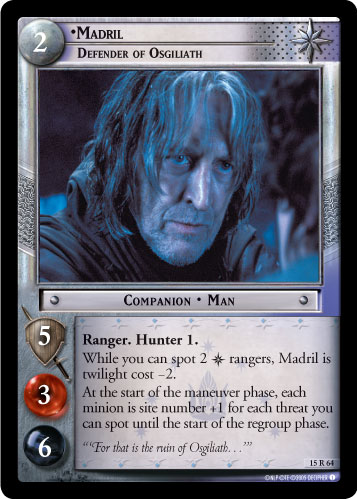 , Ithilien Blade (15C62)
, Ithilien Blade (15C62)
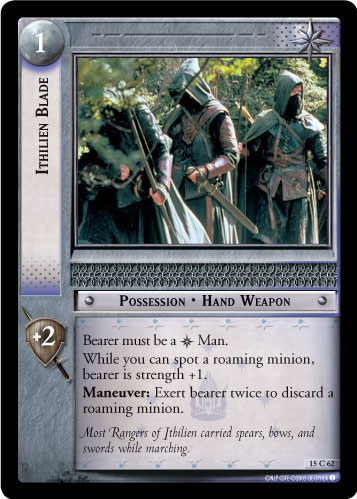 , Aragorn, Thorongil (15R55)
, Aragorn, Thorongil (15R55)
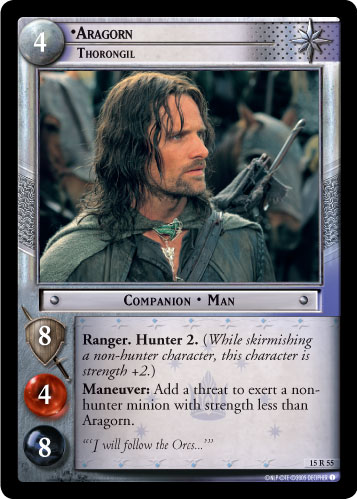 , and Mountain-troll (15R112)
, and Mountain-troll (15R112)
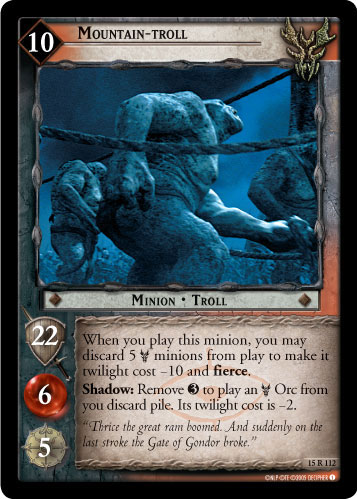 .
.
Themes and Mechanics[edit]
Most of the mechanics of The Hunters were focused around either the hunter keyword or the trio of Aragorn, Gimli, and Legolas, named the three hunters in the books and movies. Ents were included in the set for the first time since Towers Block (appearing again in Gandalf with support from
Shire), and site control returned after being absent in War of the Ring Block (appearing in
Men and
Uruk-hai).
Cultures[edit]
The Hunters continued with the same set of cultures as the previous War of the Ring Block. It did not feature any cameos from movie-era shadow cultures.
One card, Forth the Three Hunters! (15C60)
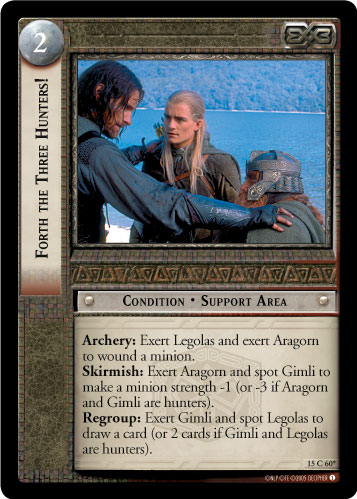 appeared in three versions with identical rules text, but different cultures:
appeared in three versions with identical rules text, but different cultures: Dwarven,
Elven, and
Gondor. Because deck construction was based on the name of a card, decks could include four copies of the card in total, in any combination of cultures.
The Hunters continued the trend from Black Rider of printing unique minions in different cultures than their original appearance, including:
- Bill Ferny, Agent of Saruman (15R72)
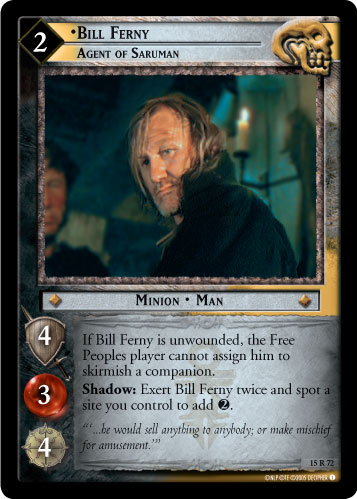 originally appeared in
originally appeared in Wraith
- Mûmak Commander, Giant Among the Swertings (15R86)
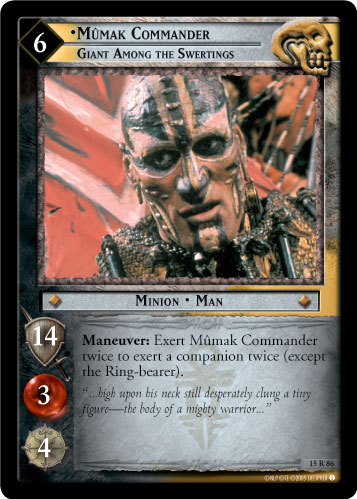 originally appeared in
originally appeared in Raider
- Gorbag, Filthy Rebel (15R109)
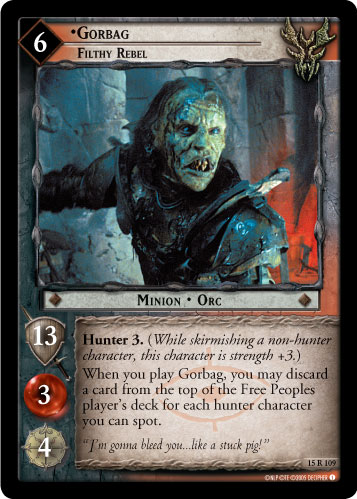 originally appeared in
originally appeared in Wraith
- Lurtz, Now Perfected (15R162)
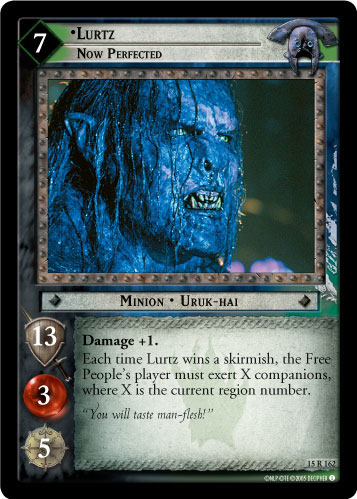 originally appeared in
originally appeared in Isengard
- Mauhúr, Relentless Hunter (15S164)
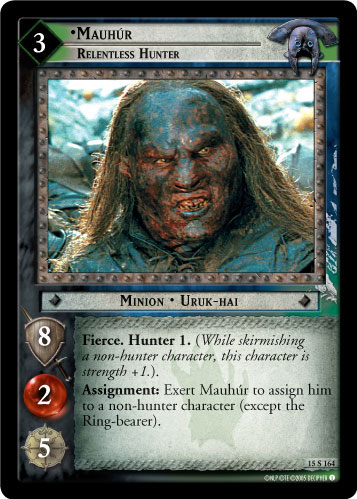 originally appeared in
originally appeared in Isengard
- Uglúk, Ugly Fellow (15R172)
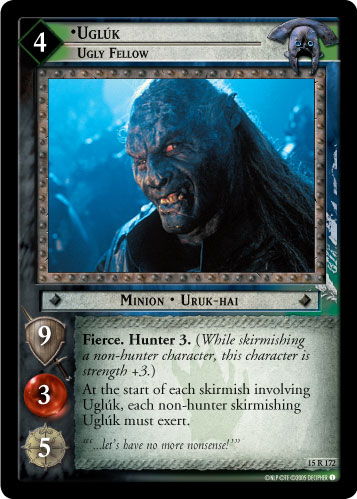 originally appeared in
originally appeared in Isengard
In addition, The Hunters marked the first time that unique possessions were printed in new cultures. Both Lurtz’s Sword, Mighty Longsword (15R163)
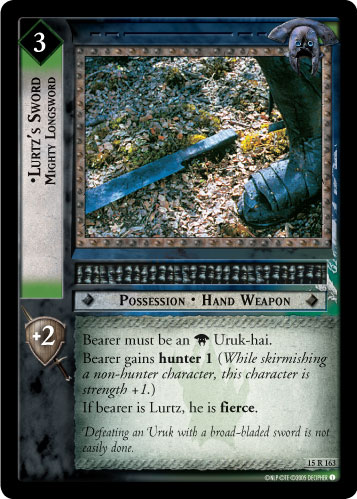 and Uglúk’s Sword, Weapon of Command (15R173)
and Uglúk’s Sword, Weapon of Command (15R173)
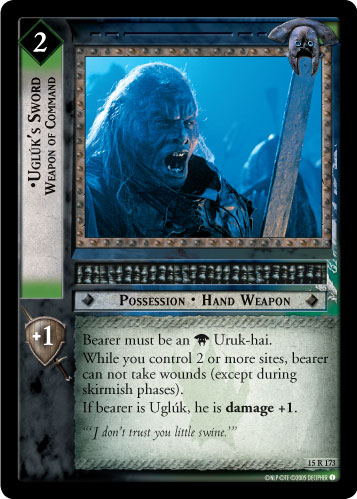 had original versions (without subtitles) printed in
had original versions (without subtitles) printed in Isengard.
New Loaded Keyword[edit]
The Hunters introduced one new loaded keyword, Hunter, a numeric keyword. Characters with "Hunter X" had +X strength when skirmishing a character without the hunter keyword. The keyword was very controversial, in large part because of the self-referential nature of the keyword; there were no cards printed before The Hunters with the hunter keyword, which meant that newer cards had a blatant advantage over older cards.
Some characters had the hunter keyword in place of other abilities that similar cards would have; for instance, Gimli, Eager Hunter (15C5)
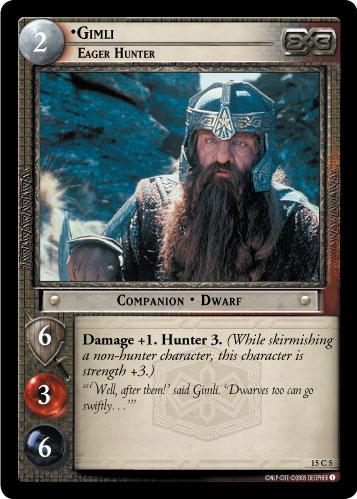 follows the pattern of most Gimli cards, having damage +1 and another ability, in this case hunter 3. However, many characters had hunter in addition to a normal set of rules text, adding to the sense of power creep in the set. As an example, Aragorn, Thorongil (15R55)
follows the pattern of most Gimli cards, having damage +1 and another ability, in this case hunter 3. However, many characters had hunter in addition to a normal set of rules text, adding to the sense of power creep in the set. As an example, Aragorn, Thorongil (15R55)
 has the ranger keyword, a strong maneuver ability, plus hunter 2.
has the ranger keyword, a strong maneuver ability, plus hunter 2.
Unloaded Keywords[edit]
The Hunters did not introduced any new unloaded keywords.
Starter Decks[edit]
Continuing the pattern from Shadows, many of the cards in starter packs did not appear in boosters and could only be obtained by buying a starter pack; these cards were all given the rarity symbol S. Both decks contained sites from War of the Ring Block, in part because The Hunters only had eight sites included in the set; this is the first time a starter deck had contained any cards from a previous block.
The face cards for the starter decks were Aragorn, Swift Hunter (15S54)
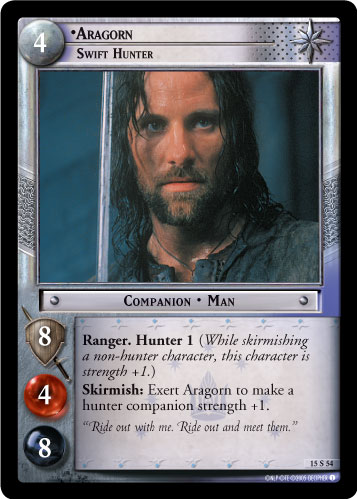 and Mauhúr, Relentless Hunter (15S164)
and Mauhúr, Relentless Hunter (15S164)
 . Each deck contained contained four copies of its face card, rather than the usual two. The Aragorn deck is the second time that a face card companion was not intended to be played as part of the starting fellowship; instead, Aragorn was meant to be tutored using City Gates (15S189)
. Each deck contained contained four copies of its face card, rather than the usual two. The Aragorn deck is the second time that a face card companion was not intended to be played as part of the starting fellowship; instead, Aragorn was meant to be tutored using City Gates (15S189)
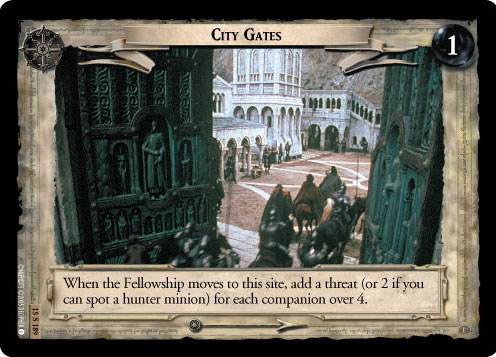 . The first time this happened was in the Aragorn Starter Deck from the Two Towers, which used the similar site The Riddermark (4U328)
. The first time this happened was in the Aragorn Starter Deck from the Two Towers, which used the similar site The Riddermark (4U328)
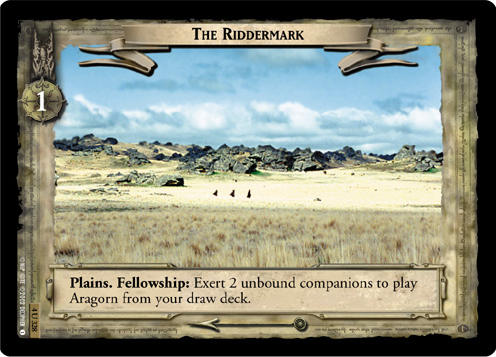 to tutor for Aragorn.
to tutor for Aragorn.
Cycles[edit]
| Free Peoples Cycles | |||
|---|---|---|---|
| Cycle Name | |||
| Three Hunters conditions | Whatever End (15C10)
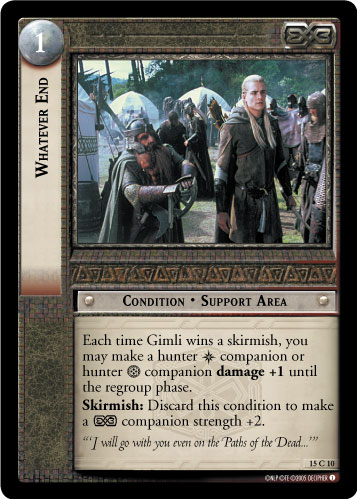
|
Focus (15C15)
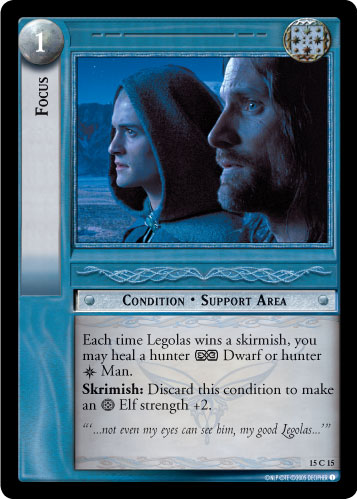
|
No Quicker Path (15C65)
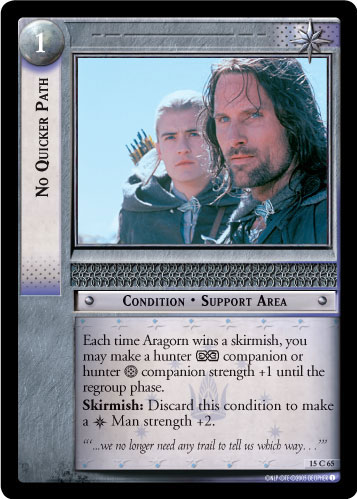
|
| Conditions with one ability that triggers each time one of the three hunters (Aragorn, Gimli, or Legolas) wins a skirmish, and another ability to discard the condition to make a companion strength +2. | |||
| Shadow Cycles | |||
|---|---|---|---|
| Cycle Name | |||
| Anti-large companion minions | Primitive Savage (15R87)
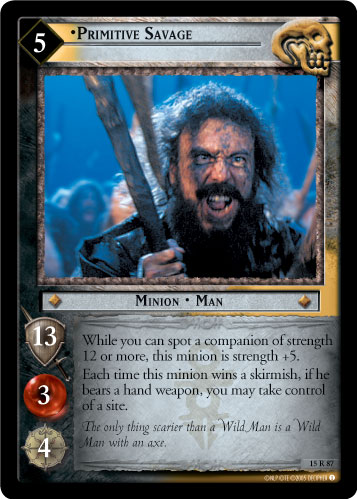
|
Black Land Commander (15C100)
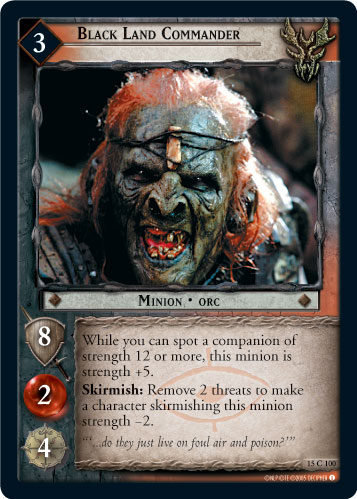
|
Uruk Village Stormer (15C178)
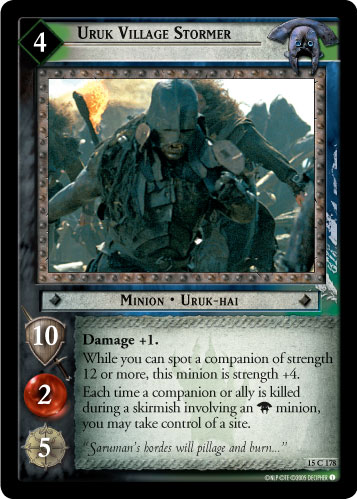
|
| Minions that increase in strength when you can spot a companion with strength 12 or more. | |||
| Anti-site replacement conditions | Rapid Reload (15U89)
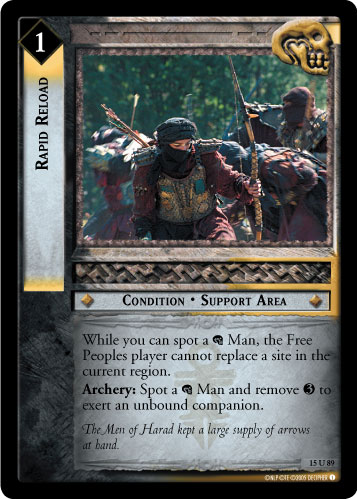
|
Orkish Camp (15U113)
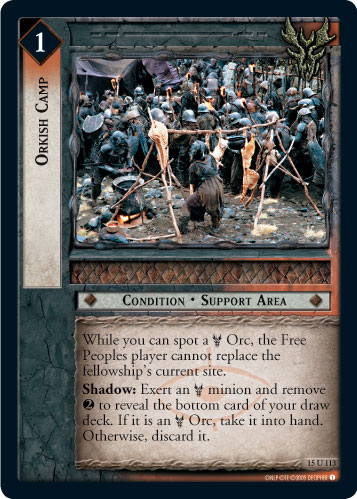
|
Defensive Rush (15U159)
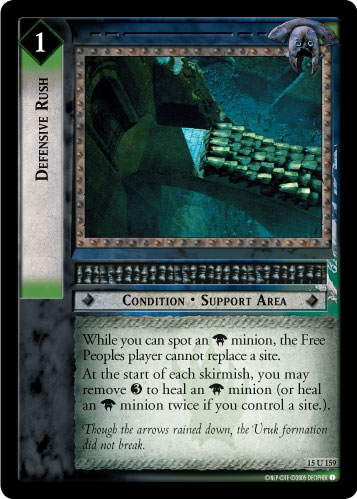
|
| Conditions that prevent the Free Peoples player from replacing certain sites. | |||
Reprinted Cards[edit]
- The One Ring, The Ruling Ring (15S2)
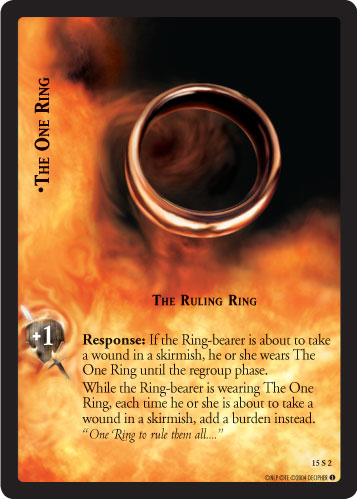 (previously 1C2, 4C2, 7C1, and 11S2)
(previously 1C2, 4C2, 7C1, and 11S2) - Elven Bow (15C13)
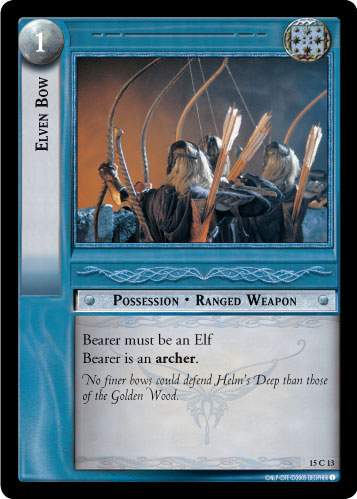 (previously 4U62)
(previously 4U62) - Ent Avenger (15C28)
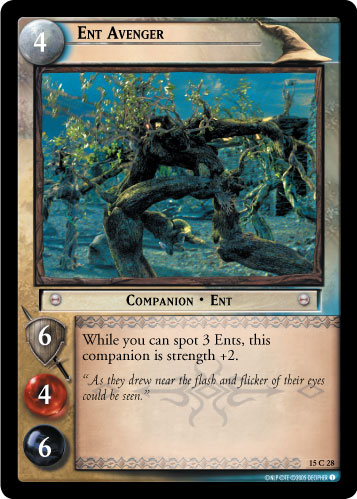 (previously 6C27)
(previously 6C27) - Rider’s Mount (15C133)
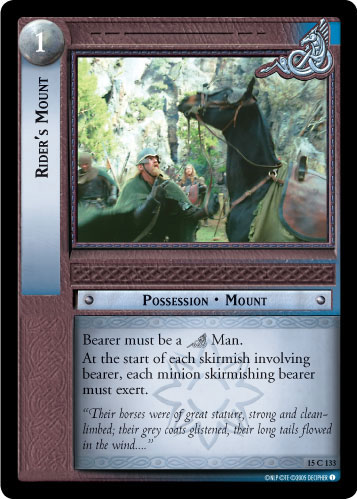 (previously 4C287)
(previously 4C287) - Hobbit Sword (15C145)
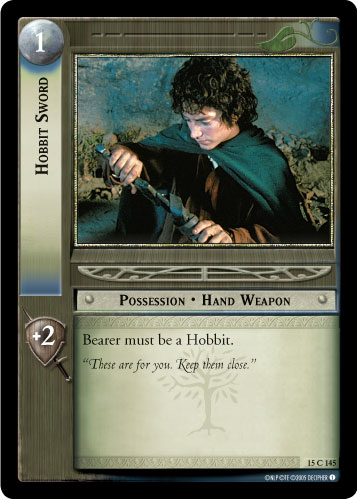 (previously 1C299, 4C306, 7C319, and 11S166)
(previously 1C299, 4C306, 7C319, and 11S166)
Similar Sites[edit]
With the introduction of the redesigned site path in Shadows, Decipher began reprinting a number of sites from previous sets with modifications to fit the new site path. They generally kept their original name and abilities, but no longer had a site number, and had a lower twilight cost to account for the twilight added by the region. If the site had been a sanctuary, that keyword was removed, since the sanctuary keyword was now granted automatically to any site played in position 3 or 6. Some sites had additional changes, which are noted below.
- City Gates (15S189)
 (previously 7U344) - Now adds one or two threats depending on whether you can spot a hunter minion, and does not remove threats when the fellowship moves.
(previously 7U344) - Now adds one or two threats depending on whether you can spot a hunter minion, and does not remove threats when the fellowship moves. - East Wall of Rohan (15S190)
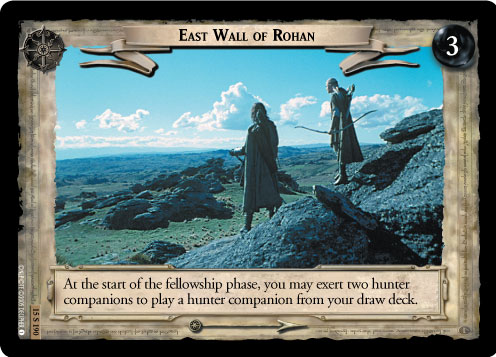 (previously 4U323) - Despite having the same name and art as the original site, the abilities are unrelated. The new site is more similar to the cycle of Eastemnet Gullies (4U325)
(previously 4U323) - Despite having the same name and art as the original site, the abilities are unrelated. The new site is more similar to the cycle of Eastemnet Gullies (4U325)
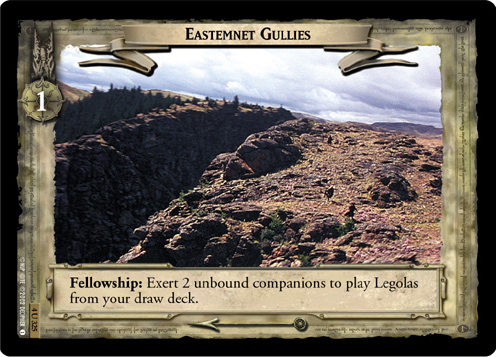 , Plains of Rohan (4U327)
, Plains of Rohan (4U327)
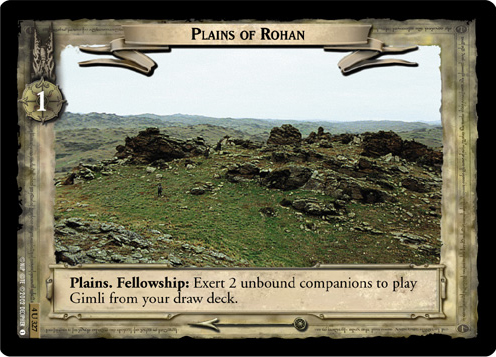 , and The Riddermark (4U328)
, and The Riddermark (4U328)
 .
. - Isengard Ruined (15U192)
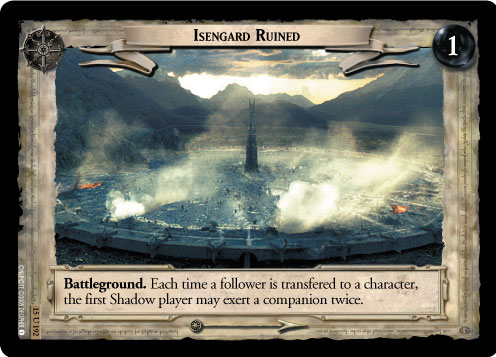 (previously 7U331) - Despite having the same name and art as the original site, the abilities are unrelated.
(previously 7U331) - Despite having the same name and art as the original site, the abilities are unrelated.
Notable Cards[edit]
- The One Ring, The Ring of Doom (15R1)
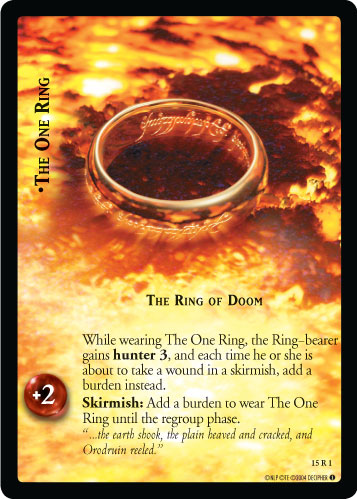
- Forth the Three Hunters! (15C60)
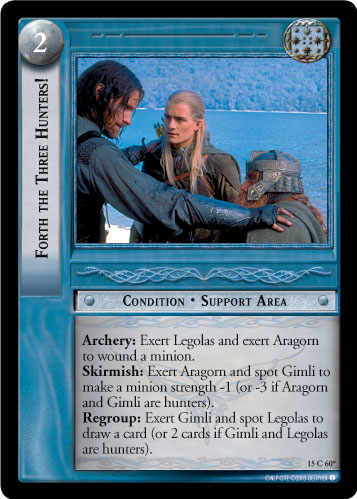
- Aragorn, Swift Hunter (15S54)

- Aragorn, Thorongil (15R55)

- Ithilien Blade (15C62)

- Mountain-troll (15R112)

- Mauhúr, Relentless Hunter (15S164)

X-Listed Cards[edit]
- Madril, Defender of Osgiliath (15R64)
 - X-listed in Standard on January 29, 2007
- X-listed in Standard on January 29, 2007
- ↑ Based on the Oversized promotional card The One Ring (4M1)
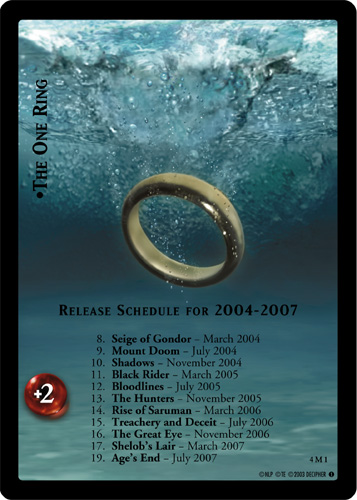 .
.